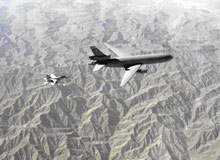
The US Department of Defense consumes a staggering amount of fuel. In 2007 it spent $12.7bn on devouring the equivalent of 132.5m barrels (or 363,000 barrels per day) of oil, nearly double the total fuel use in Ireland and 20 times the volume used by Iceland.
And these figures are after the US military made significant progress in reducing its fuel consumption. In 2003, it used 145.1m barrels (or 397,500 barrels per day), 9.5% higher than in 2007.
This decline has taken place despite the wars in Iraq and Afghanistan.
Unsurprisingly in these grim economic times, the continued pressure on the military to reduce consumption is relentless. Even a 5% cut in the fuel bill would save the Department of Defense $635m, based on 2007 levels.
But there are also sound strategic reasons for becoming more fuel efficient, including reducing Washington’s dependence on oil from volatile regions such as the Middle East. Many lives are also lost transporting fuel to the frontline in vulnerable convoys.
Furthermore the Department of Defense wants to be seen to be doing its bit for the environment.

US Tariffs are shifting - will you react or anticipate?
Don’t let policy changes catch you off guard. Stay proactive with real-time data and expert analysis.
By GlobalDataUSAF leads the way
The US Air Force is thought to lead other services in the development of energy-conservation measures, including the adoption of new technology and the development of alternative fuels.
To gain an insight into the current situation, we spoke to Dr Gary Leatherman, senior associate, energy technology and markets, at Booz Allen Hamilton, a strategy and technology consulting firm. Booz Allen Hamilton is working closely with the US Government to reduce the military’s fuel consumption.
Leatherman says: “The bulk of the US military’s energy consumption – 75% – is composed of transport fuel, and a big chunk of this is jet fuel. The remainder is accounted for by facilities.” So the USAF has perhaps the greatest incentive among the armed services to cut fuel costs.
It is easier to find energy savings in facilities than in transport, according to Leatherman. “Off-the-shelf technology, such as solar and wind power, that reduces energy consumption is already available.”
The Air Force is pressing ahead with the application of these technologies. Examples include Douglas Air Force Base in Arizona, where a large solar-power system that has just been installed is already generating megawatts.
“The transport side is a much tougher nut to crack than facilities because the fuels that are being used in the commercial sector, such as biodiesel and ethanol, don’t work well as jet fuel,” says Leatherman. “So technology needs to be developed much further on the military side.”
However Leatherman points out that projects are already underway to address the challenge. These include the ADVENT programme, in which the UK engine maker Rolls-Royce is collaborating with the US Air Force to develop a fuel-flexible, high-efficiency, high-performance jet engine.
The USAF undoubtedly faces a significant challenge to match efficiency and performance. “You don’t want to go to war in a Yugo,” quips Leatherman, “but the military is deadly serious about this. It has ambitious goals but it certainly looks to be on the right track.”
Leatherman says that all the services are looking at reducing their carbon footprint but he confirms that the USAF leads the field in this arena. The Air Force’s goal is that half of all the fuels used in domestic training flights will come from synthetic, or non-petroleum, sources by 2016.
The USAF has also made a commitment that the carbon footprint of such fuel will be at least as good as, if not better than, the carbon footprint of petroleum products. Leatherman says that the Air Force is exploring the possibility of, “looking at a mixture of coal and biomass to liquids with carbon-capture sequestration to achieve those goals”.
Credit crunch challenge
Leatherman points out that the Air Force faces a challenge to fulfil its commitment by 2016, simply because it has to rely on the private sector to build the plants. “This is expensive and, given the present credit crisis, it may prove difficult to get the plants underway in the near future. But the Air Force will certainly make great progress. It has already qualified the B-52 engines for synthetic fuel and is moving on to several other aeroplanes, platforms and engines.”
He adds: “The USAF will have qualified its planes for synthetic use by 2011. The only question is whether the private sector will have the synthetic fuels available in the quantities that will be needed.”
Several factors are driving the quest for lower energy consumption. On the one hand, the Air Force and the Navy seek to reduce costs. On the training side they are striving to find the “ideal balance between flying and simulation so that they maintain pilot combat readiness in the most efficient manner,” says Leatherman.
Environmental and security matters are also very important. In January 2007, President Bush issued Executive Order 131423, which sets clear environmental targets for all government agencies, including the Department of Defense.
In December 2007 he signed the Energy Independence and Security Act of 2007, which was designed to improve fuel economy and help to reduce US dependence on foreign supplies of oil.
Leatherman says that any fall in oil prices is unlikely to slow the drive to improve fuel efficiency. “In terms of cost,” he says, “oil prices might be down now but they will inevitably rise again and I hope we have learned our lesson in this respect. There are also national security concerns that should be addressed irrespective of the price of oil.”



